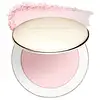What's inside
What's inside
 Key Ingredients
Key Ingredients

 Benefits
Benefits

 Concerns
Concerns

 Ingredients Side-by-side
Ingredients Side-by-side

Zinc Laurate
Mica
Cosmetic ColorantLauroyl Lysine
Skin ConditioningSilica
AbrasiveSimmondsia Chinensis Seed Oil
EmollientEthylhexylglycerin
Skin ConditioningSodium Dehydroacetate
PreservativePhytosteryl Macadamiate
Skin ConditioningPolyglyceryl-2 Triisostearate
EmulsifyingEnterococcus Faecalis
HumectantButylene Glycol
HumectantWater
Skin ConditioningHydroxyapatite
AbrasiveZinc Oxide
Cosmetic ColorantTheobroma Cacao Seed Extract
AntioxidantChenopodium Quinoa Seed Extract
Skin ConditioningMagnesium Ascorbyl Phosphate
AntioxidantTocopherol
AntioxidantZinc Laurate, Mica, Lauroyl Lysine, Silica, Simmondsia Chinensis Seed Oil, Ethylhexylglycerin, Sodium Dehydroacetate, Phytosteryl Macadamiate, Polyglyceryl-2 Triisostearate, Enterococcus Faecalis, Butylene Glycol, Water, Hydroxyapatite, Zinc Oxide, Theobroma Cacao Seed Extract, Chenopodium Quinoa Seed Extract, Magnesium Ascorbyl Phosphate, Tocopherol
Mica
Cosmetic ColorantSilica
AbrasiveMagnesium Carbonate Hydroxide
BufferingDistarch Phosphate
AbsorbentSaccharomyces Ferment
Skin ConditioningCI 77120
Cosmetic ColorantMicrocrystalline Cellulose
AbsorbentGlycerin
HumectantHelianthus Annuus Seed Oil
EmollientMagnesium Myristate
Caprylyl Glycol
EmollientPentylene Glycol
Skin ConditioningEthylhexylglycerin
Skin ConditioningWater
Skin ConditioningLauroyl Lysine
Skin ConditioningSodium Dehydroacetate
PreservativeParfum
MaskingRaspberry Ketone
MaskingButylene Glycol
HumectantPaeonia Lactiflora Root Extract
Skin ConditioningCalcium Aluminum Borosilicate
Tocopherol
AntioxidantPalmitic Acid
EmollientDiamond Powder
AbrasiveMagnesium Hydroxide
AbsorbentPaeonia Albiflora Flower Extract
TonicGold
Cosmetic ColorantTin Oxide
AbrasiveCI 77891
Cosmetic ColorantCI 77491
Cosmetic ColorantCI 77492
Cosmetic ColorantCI 77499
Cosmetic ColorantMica, Silica, Magnesium Carbonate Hydroxide, Distarch Phosphate, Saccharomyces Ferment, CI 77120, Microcrystalline Cellulose, Glycerin, Helianthus Annuus Seed Oil, Magnesium Myristate, Caprylyl Glycol, Pentylene Glycol, Ethylhexylglycerin, Water, Lauroyl Lysine, Sodium Dehydroacetate, Parfum, Raspberry Ketone, Butylene Glycol, Paeonia Lactiflora Root Extract, Calcium Aluminum Borosilicate, Tocopherol, Palmitic Acid, Diamond Powder, Magnesium Hydroxide, Paeonia Albiflora Flower Extract, Gold, Tin Oxide, CI 77891, CI 77491, CI 77492, CI 77499
Ingredients Explained
These ingredients are found in both products.
Ingredients higher up in an ingredient list are typically present in a larger amount.
Butylene Glycol (or BG) is used within cosmetic products for a few different reasons:
Overall, Butylene Glycol is a safe and well-rounded ingredient that works well with other ingredients.
Though this ingredient works well with most skin types, some people with sensitive skin may experience a reaction such as allergic rashes, closed comedones, or itchiness.
Learn more about Butylene GlycolEthylhexylglycerin (we can't pronounce this either) is commonly used as a preservative and skin softener. It is derived from glyceryl.
You might see Ethylhexylglycerin often paired with other preservatives such as phenoxyethanol. Ethylhexylglycerin has been found to increase the effectiveness of these other preservatives.
This ingredient comes from a fatty acid (lauric acid) and amino acid (lysine). It is used to add a silky feel to cosmetics.
According to a manufacturer, its fatty acid base leaves a silky feeling on the skin. It also has emollient properties because of this. Emollients help soften skin by preventing water from evaporating.
Lauroyl lysine is barely soluble in water.
Learn more about Lauroyl LysineMica is a naturally occurring mineral used to add shimmer and color in cosmetics. It can also help improve the texture of a product or give it an opaque, white/silver color.
Serecite is the name for very fine but ragged grains of mica.
This ingredient is often coated with metal oxides like titanium dioxide. Trace amounts of heavy metals may be found in mica, but these metals are not harmful in our personal products.
Mica has been used since prehistoric times throughout the world. Ancient Egyptian, Indian, Greek, Roman, Aztec, and Chinese civilizations have used mica.
Learn more about MicaSilica, also known as silicon dioxide, is a naturally occurring mineral. It is used as a fine, spherical, and porous powder in cosmetics.
Though it has exfoliant properties, the function of silica varies depending on the product.
The unique structure of silica enhances the spreadability and adds smoothness, making it a great texture enhancer.
It is also used as an active carrier, emulsifier, and mattifier due to its ability to absorb excess oil.
In some products, tiny microneedles called spicules are made from silica or hydrolyzed sponge. When you rub them in, they lightly polish away dead skin layers and enhance the penetration of active ingredients.
Learn more about SilicaThis ingredient is a preservative with antimicrobial properties. It is the sodium salt of dehydroacetic acid.
It is especially effective at preventing bacterial and fungal growth in low concentrations.
Tocopherol (also known as Vitamin E) is a common antioxidant used to help protect the skin from free-radicals and strengthen the skin barrier. It's also fat soluble - this means our skin is great at absorbing it.
Vitamin E also helps keep your natural skin lipids healthy. Your lipid skin barrier naturally consists of lipids, ceramides, and fatty acids. Vitamin E offers extra protection for your skin’s lipid barrier, keeping your skin healthy and nourished.
Another benefit is a bit of UV protection. Vitamin E helps reduce the damage caused by UVB rays. (It should not replace your sunscreen). Combining it with Vitamin C can decrease sunburned cells and hyperpigmentation after UV exposure.
You might have noticed Vitamin E + C often paired together. This is because it is great at stabilizing Vitamin C. Using the two together helps increase the effectiveness of both ingredients.
There are often claims that Vitamin E can reduce/prevent scarring, but these claims haven't been confirmed by scientific research.
Learn more about TocopherolWater. It's the most common cosmetic ingredient of all. You'll usually see it at the top of ingredient lists, meaning that it makes up the largest part of the product.
So why is it so popular? Water most often acts as a solvent - this means that it helps dissolve other ingredients into the formulation.
You'll also recognize water as that liquid we all need to stay alive. If you see this, drink a glass of water. Stay hydrated!
Learn more about Water